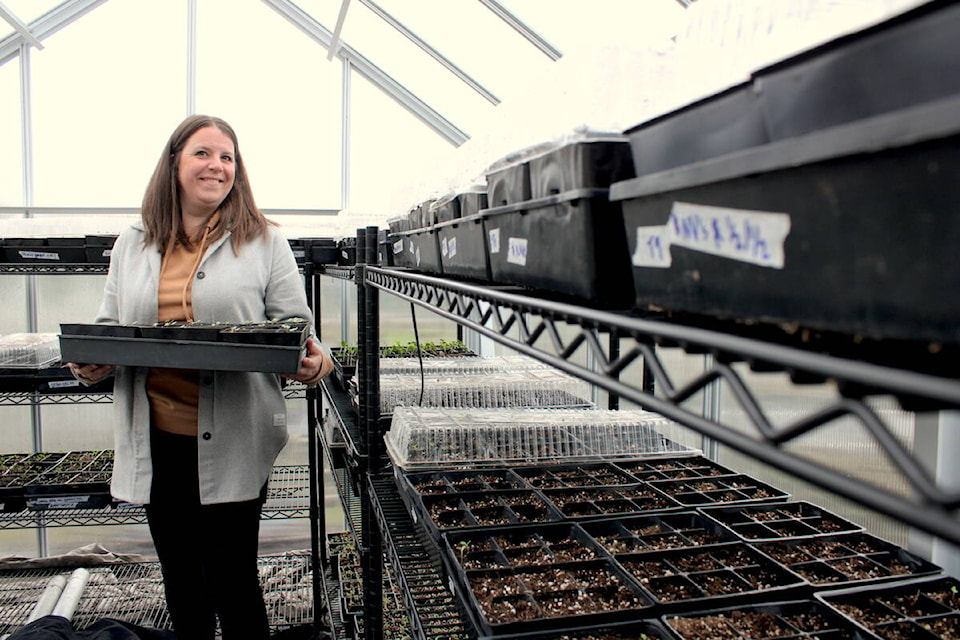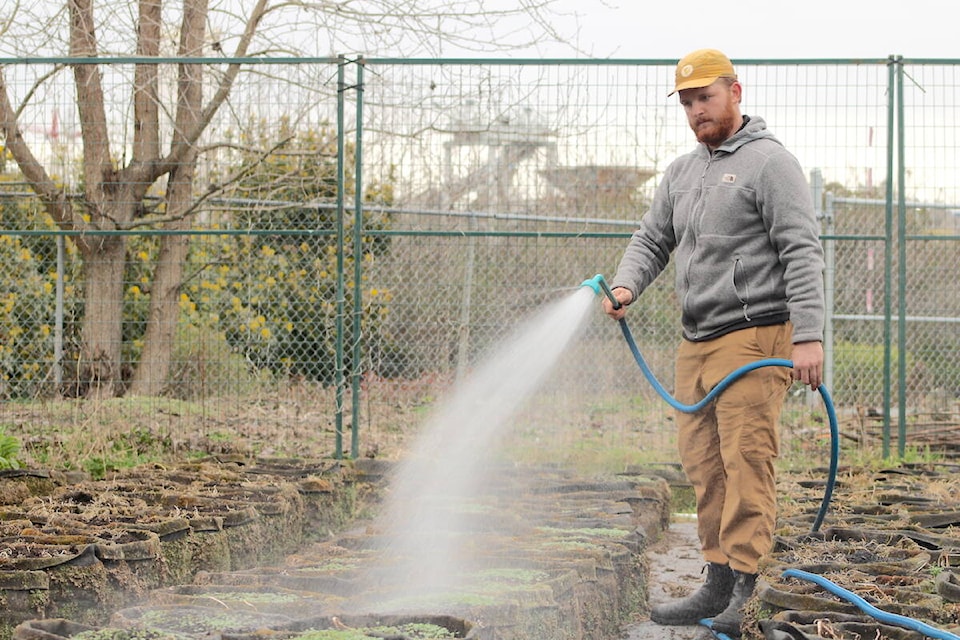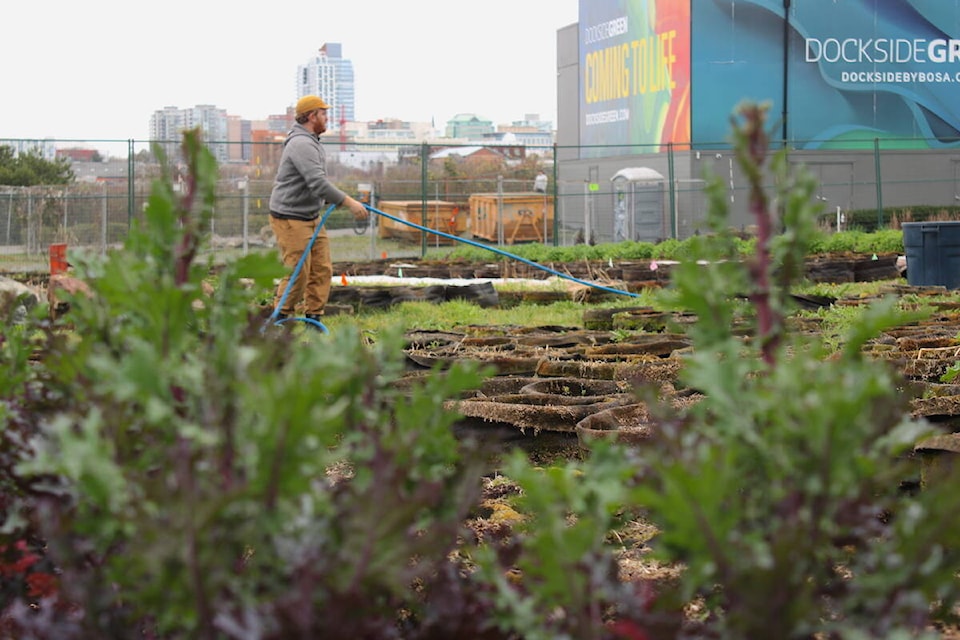Flanked by Galloping Goose trail pedalers, newly erected apartment buildings and vehicles crossing the Bay Street Bridge – multi-colour kale, arugula buds and spring onion shoots emerge from circular planters dotting FED Urban Farm.
The Vic West operation is familiar to those who pass it by or stop in to grab their weekly vegetable box, but others may be unaware the greens they enjoyed at a nearby restaurant sprung from the city-centre farm.
Now, a merger of those involved with the produce plot hope to bolster urban farming in the capital and inspire the next generation of food growers.
After partnering on projects for several years, FED Urban Agriculture, a Victoria charity, took over ownership of the farm in early March from TOPSOIL.
Now under a single banner, FED is committed to continue showing that a sustainable urban farm can be a revenue driver. But it also aims to prove the urban agriculture model can push back against industrialization of the food system and the disconnect between people and what they eat.
FED runs several food-growing education programs around Victoria, but having the farm allows them to engage more people in urban agriculture by running more workshops, scaling up production and bringing on more volunteers.
“We had been looking for our own land for years and always basically just wanted this,” said Brianna Stewart, FED’s program manager, referring to the Vic West site. “We’re really trying to demonstrate sustainable agriculture and using land that would otherwise just be sitting here vacant.”
The Island used to produce 85 per cent of its own food, but now only produces around a tenth of what residents consume. In the last two decades alone, Statistics Canada data shows the country’s total farmland fell by at least eight per cent, while B.C. saw an 11 per cent reduction during that time.
Stewart said they want to get people excited about seeing where their food comes from. Creating a more localized food system is also needed as climate change worsens extreme weather, she added, pointing to the 2021 atmospheric river rains severing key South Island routes.
“We are absolutely at risk with our supply chain and this industrial food system complex that we’re so reliant on,” Stewart said. “With all the climate-related events, we’re only going to see more challenges in getting food.”

The global food system currently contributes between 21 and 37 per cent of all greenhouse gas emissions, according to the the International Panel on Climate Change. That U.N. body has high confidence climate change is already affecting food security through increasing temperatures, changing precipitation patterns and more extreme events, but notes urban food systems may have significant positive local effects.
The Gorge Waterway divides the Victoria farm and Rock Bay industrial lands where the afternoon rumble of jackhammer-like machinery offers a reminder of the area’s industrial past. The farm itself sits where a sawmill was once instrumental in deforesting large swaths of the South Island.
That left the site’s earth tainted, but the impacted ground is deep enough that it doesn’t affect the plants being tended by Alistair Howes on the surface. While flagging how a third of arable land has been lost globally, the FED project manager said there are numerous examples of industry pulling out of small Island communities and leaving degraded urban grounds in their wake.
FED wants the Vic West farm to be a model for showing those communities what’s possible, whether it’s using those abandoned spaces to teach kids about cultivation or regenerating fertility on the damaged land.
Citing talks with engineers who tested the FED land before the farm arrived, Howes said they expect to leave its soil in a much healthier state when they leave in about 15 years. That revival is due to the farm’s no-spray and soil reuse methods, how they’ve been running water through organic compost for years and welcoming pollinators to the site, he said.

TOPSOIL launched in 2013 with a focus on urban growing and providing local chefs with veggies produced within the city. When it sprung the urban farm a few years later, it sought to rival the convenience of large-scale suppliers and reliably provide fresh leafy produce to chefs a couple of blocks away who were dismayed by the quality of industrial greens.
The farm aimed to supply local restaurants with about 300 pounds of greens every week pre-pandemic. It’s now shifted to also going directly to the consumer through an on-site market and a weekly veggie box pick-up program.
The two groups first collaborated on the My FED Farm project, which sent over 1,000 free containers filled with food growing essentials to those disproportionately affected by the pandemic. While recipients got to grow a lot of produce, Howes was more moved by emails from them saying the connection they got from caring for the plants really helped them emotionally during an isolating time.
Many existing farmers are aging quickly and plans to replace them are lacking, meaning large companies will continue to buy up farms and compound current production issues, Howes said.
The micro farm hopes to provide a solution by getting young people excited about farming through a training program that would tackle both the production and entrepreneurial aspects of the job. It already gets a lot of interest from youth who are concerned about the future, but see the farm as a tangible climate solution, Stewart said.
“(The farm) is and has been a community food asset, but it has not done all it could in terms of engaging the community and telling people why these kinds of food systems are important,” Howes said.
The organization hopes its efforts prompt new urban food growing opportunities across Greater Victoria’s land, downtown planter boxes, gardens and rooftops.
READ: Greater Victoria projected to face worse heat waves, more extreme rain



